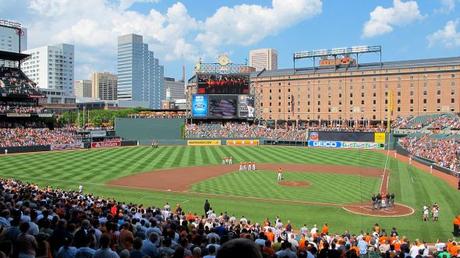
Oriole Park At Camden Yards, 2013 (Wikipedia)
Oriole Park at Camden Yards, frequently referred to as just Camden Yards or Oriole Park, opened as the official home of the Baltimore Orioles on April 6, 1992. The stadium had been built to replace Memorial Stadium, a multipurpose stadium that had served as home not only to the Orioles, but throughout its life also hosted the minor league Bowie Baysox (1993), the Baltimore Colts of the National Football League (from the late-1940s to the early-1980s), the Baltimore Stallions of the Canadian Football League (1994-95), the Baltimore Ravens of the NFL (1996-97), and also served as the venue for various high school and college athletic events.
Oriole Park was built as a baseball-only facility in downtown Baltimore. When the city of Baltimore and the Maryland government refused to commit money to replace Memorial Stadium, the Baltimore Colts responded by moving to Indianapolis in 1984. Realizing that the city could also potentially lose the Orioles, city and state officials immediately began planning a new park in order to keep them in town.
Initially, the architectural firm Helmuth, Obata & Kassabaum (HOK) Sport Venue Event (now known as Populous) proposed a design similar to that of the new Comiskey Park. The Orioles turned down the proposal, however, in favor of a more retro-style stadium, wishing instead to follow in the footsteps of the great old ballparks like Fenway, Wrigley, and Ebbets. The new stadium would feature steel, rather than concrete trusses, an arched brick facade, a sun roof over the upper deck, an asymmetrical playing field, and natural grass turf. Construction of the new stadium began in 1989 and lasted 33 months, costing approximately $110 million.
The field itself is set sixteen feet below street level and is comprised of a sophisticated irrigation and drainage system below the grass turf. The purpose of this design is to reduce the frequency of rainouts by shortening the length of rain delays. The field’s system makes it possible to get the field ready for play within half-an-hour after the end of a heavy rain. An impressive feat of engineering, the drainage system can remove as much as 75,000 gallons of rainwater from the field in an hour.
The B&O warehouse that serves as a backdrop beyond the right field wall was a point of contention in the stadium’s design plan. Many people wanted the warehouse demolished, while others fought to leave it in place. Still others liked the idea of using the warehouse as the right-field wall instead of the backdrop. Perhaps it is fitting that the warehouse remains, given the name ultimately bestowed upon the new stadium, though it didn’t end up being the stadium’s right field wall — Eutaw Street separates the stadium from the warehouse, instead. The floors of the warehouse contain offices, service spaces, and a private club. The warehouse has never been hit by a legal home run during regulation play. However, several players have reportedly struck the wall during batting practice, and it was hit by Ken Griffey, Jr. during the Home Run Derby of the 1993 MLB All-Star Game.
Former Orioles owner Eli Jacobs favored naming the new venue Oriole Park. Meanwhile, Maryland Governor William Donald Schaefer preferred to name the stadium Camden Yards, after the former rail terminal at the site operated by the Baltimore & Ohio (B&O) Railroad. After considerable debate, a compromise was reached and it was decided that both names were to be used: Oriole Park at Camden Yards.
Following the 2000 season, the ballpark’s infield and outfield were completely rebuilt, and the drainage system was modernized to better protect both the pipes and the playing surface. Following the 2005 season, all new irrigation heads were installed, and in 2007, the warning track around the field was replaced. In 2008, the sod was replaced with a sand-based blend of Kentucky bluegrass to give the field a more vibrant green color. After the 2008 season, a new HD video display and scoreboard were installed below the right field bleachers. Before the start of the 2011 season, the seats in the lower seating bowl were replaced and several skyboxes were eliminated and refurbished to make room for more party suites and casual luxury boxes. The renovation reduced the park’s capacity from 48,876 to 45,971.
Notable events at Camden Yards over the years include the aforementioned hosting of the 1993 All-Star Game. On June 18, 1994, one of the stadium’s multiple-story escalators, overcrowded with fans heading to their upper-deck seats, jerked backward, throwing passengers to the bottom landing. The accident resulted in 43 people injured. On September 6, 1995, Camden Yards witnessed Cal Ripken, Jr.’s record-setting 2,131st consecutive game, and one year later, Eddie Murray blasted the 500th home run of his career at the ballpark.
In 2012, the park celebrated the twenty-year anniversary of its opening, launching the website CamdenYards20.com as part of that celebration. The site featured videos of Opening Day in 1992, a written history of the park and its improvements over the years, and photo galleries of Camden Yards, featuring everything from ballpark construction to celebrity visitors.
The success of Camden Yards sparked a trend in the construction of more traditional, fan-friendly ballparks in downtown locations across the U.S. The park also ended a quarter-century trend of multipurpose stadiums in which baseball and football teams shared the same venue. Although intended to cut costs, the fundamentally different sizes and shapes of baseball and football fields ultimately made this concept inadequate for either sport. By the 2012 season, all but two MLB teams (the Toronto Blue Jays and Oakland Athletics) played in baseball-only parks.


